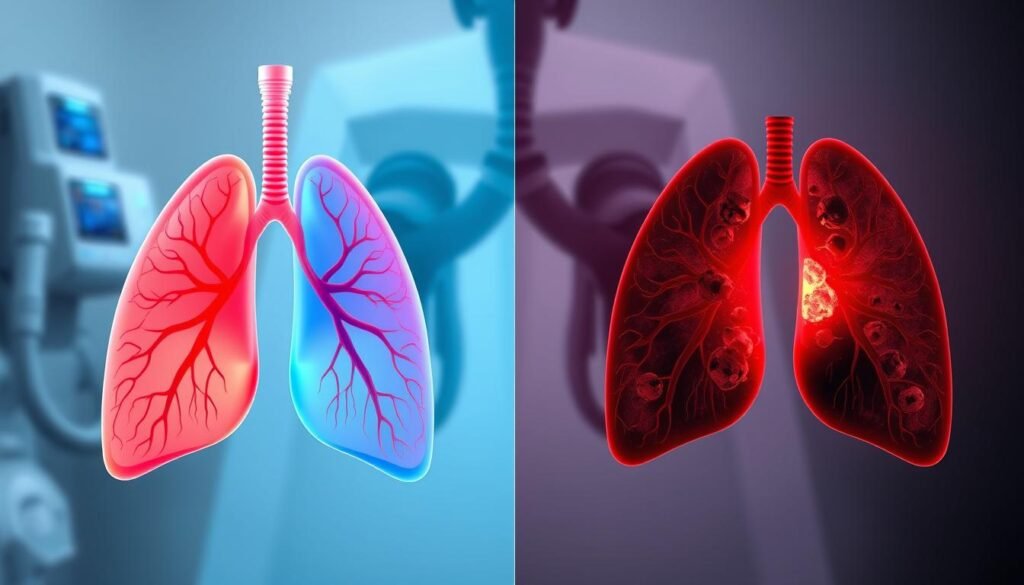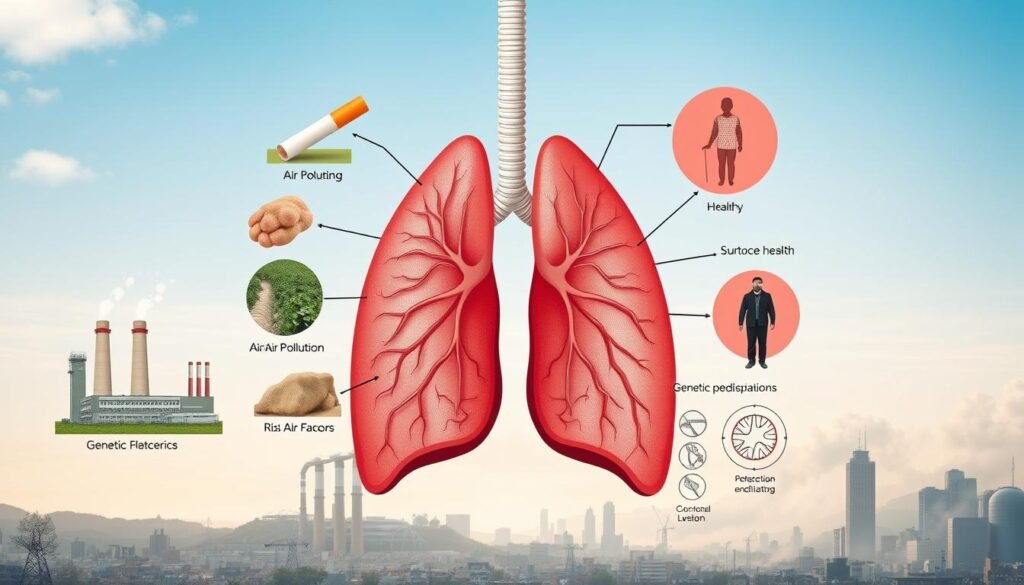Lung cancer is currently the top cause of cancer deaths in the U.S. It’s responsible for about 1 in 5 cancer deaths. But there’s good news: the lung cancer survival rate has risen by 26% over the last five years. Now, 28.4% of patients can expect to survive for five years after being diagnosed. The 2024 “State of Lung Cancer” report by the American Lung Association brings new insights. It talks about the progress in diagnosing lung cancer, advances in treatment, and how early detection improves chances of survival. However, there are still hurdles to overcome, especially in getting everyone access to in-depth biomarker testing. This testing is critical for creating personalized treatment plans.
Key Takeaways
- Lung cancer’s survival rate has improved by 26% in the last five years.
- The national average five-year survival rate for lung cancer is currently 28.4%.
- Only 15 states mandate insurance coverage for comprehensive biomarker testing.
- Rhode Island has the highest lung cancer screening rate at 28.6%, while Wyoming has the lowest at 8.6%.
- Nationally, only 27.4% of lung cancer cases are diagnosed early.
Introduction to Lung Cancer
Lung cancer is the second most common cancer in the United States. It affects both men and women. Often, it’s not found until it’s very advanced. Lung cancer overview knowledge is key to boosting lung cancer awareness. This could help save lives.
Main causes of lung cancer are smoking, secondhand smoke, and air pollution. Lung cancer facts show that smoking is a major preventable cause. It’s important to educate people to stop smoking.
Survival rates for lung cancer vary greatly. It depends on the cancer type and how early it is caught. Lung cancer is more deadly than many others, except pancreatic cancer. The 5-year survival rate is under 20%.
For non-small-cell lung cancer (NSCLC), the survival rates are different. They are 60% for localized cancer but drop to 6% for advanced stages. Small-cell lung cancer (SCLC) has even lower survival rates.
By teaching people about lung cancer awareness, we can improve outcomes. Knowing about risk factors and early detection is crucial. This can lead to better prevention and higher survival rates.
Want more info on survival rates by type and stage? Visit this informative article.
Understanding Lung Cancer Types
Lung cancer is mainly grouped into two types: non-small cell lung cancer (NSCLC) and small cell lung cancer (SCLC). NSCLC makes up 80-85% of all lung cancer cases. SCLC is about 10-15%. These lung cancer classifications lead to different treatments and survival chances.
Those with NSCLC have varying survival rates based on cancer’s stage when found. Stage 1 sees about a 55% survival rate. It goes up to 65% if the cancer hasn’t spread much. But for stage 2, it drops to 35%. At stage 3, it decreases to 15%. By stage 4, survival rates drop sharply to just 5%. It shows how vital early detection is.
On the other hand, SCLC patients usually have a tougher time. About 30% with early-stage SCLC survive five years. This drops to 18% for regional stages, and distant-stage cases have only a 3% chance. SCLC’s aggressiveness makes survival rates low, highlighting this cancer’s severity.
Knowing the differences between these cancers helps in choosing the right treatment. Many factors, like the cancer’s stage and patient health, affect survival chances. You can find more stats at the Cancer Research UK website.
| Cancer Type | Stage | Five-Year Survival Rate |
|---|---|---|
| NSCLC | Localized | 65% |
| NSCLC | Regional | 37% |
| NSCLC | Distant | 9% |
| SCLC | Localized | 30% |
| SCLC | Regional | 18% |
| SCLC | Distant | 3% |
Lung Cancer Survivability Rate: Latest Statistics 2024
Lung cancer is a major concern due to its scary stats. The overall survival rates are getting better. This is thanks to new treatments. The lung cancer statistics 2024 show a five-year survival rate at about 26.7%.
Overall Survival Rates
The five-year survival rate for localized lung cancer is 63.7%. This is much higher than for advanced stages. For NSCLC, localized cases have a 65% survival rate. But, it drops to 9% for distant-stage cases. SCLC patients see a drastic fall to a 3% survival rate for distant-stage cancer.
Survival by Cancer Type
It’s key to know the survival rates by cancer type. NSCLC and SCLC rates show big differences. This highlights SCLC’s aggressive nature. The survival rate for localized SCLC is 30%. For all stages, it falls to 7%. There’s an urgent need for better treatments.
State-by-State Variations in Survival Rates
State survival rates show big gaps. Massachusetts has the highest rate at 37.9%. Oklahoma has the lowest at 22.2%. This shows how healthcare access and policies affect outcomes. It’s vital for patients and policymakers to understand these differences.
Factors Affecting Lung Cancer Survival
Various elements influence the prognosis for lung cancer patients. The stage at diagnosis and treatment options are key. Knowing these factors helps patients make wise care decisions.
Stage at Diagnosis
The stage of lung cancer at diagnosis is key to survival. Early stage diagnosis means a much better chance of surviving. A five-year survival rate can be as high as 64%. Sadly, only 27.4% of lung cancer is found early. Late-stage diagnosis means the survival rate drops significantly.
Treatment Options and Their Impact
The type and stage of lung cancer determine treatment options. Treatments can include surgery, chemotherapy, and radiation. Surgery often works best for those found in the early stages. They have a higher chance of curative treatments. Overall, about 87.6% of patients receive some treatment. However, around 20.9% get no treatment, sometimes due to lack of knowledge or stigma. It’s crucial to understand these options to improve outcomes for lung cancer patients.

The Importance of Early Detection
Finding lung cancer early is key to helping people live longer. If you’re 50 to 80 years old and have smoked a lot, you should get checked every year. This can catch lung cancer early when it’s easier to treat, which makes a big difference. People found with early lung cancer have an 80 percent chance of living 20 more years.
Screening Recommendations
The U.S. Preventive Services Task Force recommends a specific scan for lung cancer. It’s for adults who’ve smoked a lot in the past. This scan, called low-dose computed tomography (LDCT), can lower the chance of dying from lung cancer by about 20 percent. That’s a lot better than regular chest x-rays. Catching cancer early is crucial since only about 18.6 percent of people survive lung cancer after five years, without it.
Current Screening Rates
Even though lung cancer screening saves lives, not enough people are getting it. In 2023, only 16 percent of people who should get screened actually did. This shows we need to work harder at finding lung cancer early. Rhode Island is doing the best with a screening rate of 28.6 percent. Wyoming is the lowest at 8.6 percent. We need to make screening more available to increase these numbers nationally.
| State | Screening Rate (%) |
|---|---|
| Rhode Island | 28.6 |
| Wyoming | 8.6 |
| National Average | 16 |
The Role of Biomarker Testing in Survival
Recent studies show that biomarker testing is key for picking the best lung cancer treatments. By examining changes in a tumor’s DNA, doctors can offer precision medicine. However, not everyone gets these tests. About 61% of healthcare professionals say their lung cancer patients don’t get biomarker testing.
The FLAURA trial is important. It found that patients getting osimertinib lived around 38.6 months. This is longer than the 31.8 months for those with standard care. The trial points out how crucial targeted therapies are. They work especially well for patients with specific biomarkers like EGFR, ALK, or ROS1. For non-small cell lung cancer (NSCLC), treatments targeting these biomarkers are approved.
Another interesting find is about pembrolizumab, an immune checkpoint inhibitor. It has a five-year survival rate of 32% in NSCLC patients. About 30% of those with advanced NSCLC have a lot of PD-L1 protein. This makes them good candidates for these new treatments.
Several biomarkers, like ALK, BRAF, and KRAS, complicate treatment choices. For example, K-Ras mutations are in about 20% of NSCLC cases. These mutations are linked with a higher chance of dying. Patients with these mutations face a 63% mortality rate over three years. This shows why biomarker testing is crucial for figuring out a patient’s outlook.
As more people survive lung cancer, the demand for thorough biomarker testing grows. Better insurance coverage and laws could make these tests more accessible. More patients would get the benefit of personalized treatment plans. Adding biomarker testing to regular care could really change how long lung cancer patients live.

Health Disparities in Lung Cancer Outcomes
Lung cancer health disparities make it hard to get fair results for all groups. Racial factors hugely impact lung cancer diagnosis, treatment, and survival rates. African Americans, for instance, have a 32% higher lung cancer rate than European Americans. This difference shows a need for specific steps to help improve outcomes for minorities.
Racial and Ethnic Factors
On average, African Americans are diagnosed with lung cancer three years earlier than European Americans. Also, a large study with over 126,000 people found African Americans have a 30% higher risk of adenocarcinoma. They also have a 70% higher risk of squamous cell carcinoma compared to Europeans. It’s noted that tobacco companies targeted African Americans with menthol products. This led to higher menthol cigarette use among them, increasing their lung cancer risk.
There are lung cancer disparities even among non-smokers. Differences between African Americans and European Americans are significant. The good news is the gap in lung cancer rates is narrowing since the 1970s. Still, the effects of past disparities linger. There’s a need to continue efforts to bridge this gap. The five-year lung cancer survival rate has improved but big disparities still exist.
Access to Treatment and Screening
Getting access to healthcare is key to surviving lung cancer. Differences in treatment access can delay vital care. For example, survival rates for cancer patients can widely vary based on jobs, with a 89.66% survival rate for professionals versus 83.17% for laborers. This shows how crucial healthcare access is for cancer prognosis.
Access to lung cancer screening is also critical for early diagnosis and treatment. Screenings should be made with everyone in mind, especially those often overlooked. Better healthcare and treatment access can lead to major progress in tackling lung cancer disparities.
Lung Cancer Risk Factors
Fighting lung cancer involves knowing several risk factors. Understanding these factors is key in preventing lung cancer. Smoking, exposure to secondhand smoke, work-related hazards, and polluted air are major causes.
Smoking Cessation
Smoking is the top cause of lung cancer. Stopping smoking is crucial for lowering this risk. There are programs that help people quit smoking. Quitting smoking greatly reduces lung cancer risks over time. This shows how important support systems are.
Secondhand Smoke Exposure
Secondhand smoke seriously increases lung cancer risks, especially for nonsmokers around smokers. It can cause major health issues. We need laws to lessen exposure to secondhand smoke. Protecting people from this risk is very important.
Occupational Hazards
Work-related dangers also lead to lung cancer. Some jobs increase people’s exposure to cancer-causing agents. It’s important to know about and control these risks at work. Safety steps are needed to lower exposure to dangerous substances.
Air Pollution and its Effects
Air pollution is a big environmental risk for cancer. Research shows more pollution leads to more lung cancer cases. To fight air pollution, we need individual and group efforts. These efforts should focus on making the air cleaner and lessening cancer risks from the environment.

Advancements in Lung Cancer Treatment
Recent strides in lung cancer care have greatly improved patient survival. Innovations such as targeted therapies and immunotherapy are changing the treatment landscape. These advances come from deep lung cancer research, which aims to find new ways to fight different lung cancer types.
One big leap forward is in immune checkpoint inhibitors. These new treatments have doubled survival for many with advanced lung cancer. Also, treatments like stereotactic ablative radiotherapy (SABR) show a 70% two-year survival rate. This rate beats traditional radiotherapy methods.
Lung cancer research highlights improved surgical procedures like VATS lobectomy. This surgery has low in-hospital death rates and high five-year survival rates. Robotic surgeries offer another good option. They lead to quicker recovery and less pain.
Table 1 below provides an overview of survival rates and treatment methodologies:
| Treatment Method | 1-Year Survival Rate | 5-Year Survival Rate |
|---|---|---|
| Stereotactic Ablative Radiotherapy (SABR) | 70% | N/A |
| Immune Checkpoint Inhibitors | N/A | Double survival rates (specific statistics vary) |
| VATS Lobectomy | 1% in-hospital mortality | 80.1% |
| Robotic Surgery | N/A | Improved outcomes vs. open surgery |
This overview shows the big improvements in lung cancer treatments. Thanks to therapy innovations and ongoing research, patients now have better survival rates and quality of life. As research continues, the outlook for those facing this disease is getting brighter.
Conclusion
The battle against lung cancer shows how vital it is to know about the disease early. Screening and effective treatments are key. In the U.S., lung cancer is the top cause of death from cancer. We need healthcare and communities to work together. This will help more people survive lung cancer.
Many people find out they have lung cancer too late. This makes it hard for them to survive. By preventing lung cancer, like helping people stop smoking, more people can live longer. Better treatment and quick tests can also save lives. We must also fight against health inequalities linked to race and money. This way, everyone can get the care they need.
Keeping lung cancer in the spotlight is essential. It can lead to better health for all. By working together, we can help those facing lung cancer. Everyone deserves a chance to fight and win against this disease.